This summer course is an exciting opportunity for you to participate in the medical device innovation process through an experiential learning project where you will be developing a real medical device. MDIEU is a course through the Earl E. Bakken Medical Devices Center whose mission is to facilitate medical device innovation and commercialization.
MDIEU takes place over eight weeks of the summer and is open to currently enrolled University of Minnesota Twin Cities undergraduate students in any major. The course targets students who are interested in medical technology, eager to gain device development experience, and who seek leadership and team-based experiences. The course will train you to become a medical device innovator by teaching you the medical device design process. This includes how to understand clinical needs, how to design and build early-stage prototypes of medical device concepts, and how to work with a clinician to co-develop a concept, all while working on a real-world medical device that solves a clinical problem.
Along with weekly lectures and guided tutorials on topics ranging from hands-on CAD and building electronics to patent searching and how to FDA-classify your device, you will practice what you have learned by working in a team on a real medical device development project with an experienced technical mentor and a medical professional.
Need more information about the Medical Device Innovation Experience for Undergraduates (MDIEU)?
Students: Information on how to apply for the Summer 2024 course is here
Clinicians: Information on how to have your project be part of the Summer 2024 course is here
Still have questions? Contact Instructors Paul Rothweiler, [email protected]
Course Logistics for Summer 2024
- The course meets on Monday evenings, 5 pm to 7:30 pm, starting on June 3, 2024 and ending on July 22, 2024. Each class session includes a lecture component and a team meeting component. To participate in the course, you must be available to attend in-person for at least seven of the eight sessions, and preferably for all eight. Attendance at the first and last class is mandatory. The detailed program schedule will be posted mid-May.
- The course does not carry UMN course credit, but could lead to you being a named inventor on a patent application, or a co-author on a paper, plus course participation looks great on your resume.
- For Summer 2024, we will accept up to about 25 students into the course, depending on the number of projects in the course.
- You will be assigned to a project, with each project having about five students. Just before the course starts, you will be provided with information about the projects and will be able to submit your project preferences. We cannot guarantee that you will be assigned to your top project choices. The good news is that all of the projects will be awesome.
- Please be aware, if you are accepted, you will be required to sign these two forms as part of the course: Photo Release & Researcher Agreement
Past Projects & Teams
2023 Projects
Intraosseous Needle Innovation
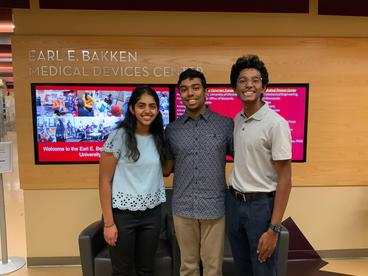
Intraosseous access is indicated in emergent situations, such as when a person experiences some type of major trauma like shock, cardiac arrest, severe dehydration, burn patients, obesity, extremely low blood pressure or severe gastrointestinal hemorrhage. In some patients, such as pediatric patients, access to peripheral veins is either not possible or delayed. The response for these cases may be to use Intraosseous (IO) access. IO access can provide the quickest way to rapidly infuse needed medications and fluids in an emergency situation.
Pediatric ER doctors need a way to safely insert intraosseous needles because of current risks associated with fluid leakage and tissue damage associated with IO needles. The solution is a self-drilling thread with a step increment to prevent the needle from driving too deep into the bone.
Team Members: Anuk Dias, Shaliny Jadhave, Dilshan Rajan, Sanab Abdi
Clinical Lead: Gwen Fischer, MD
Telehealth Device for Fundus Photography
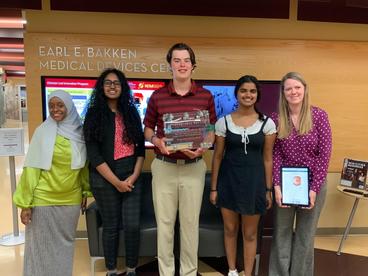
Age Macular Degeneration (AMD), is an eye disease that prevalently occurs in people from ages 50 and older, in which it hinders an individual’s central vision. The main effect with the presence of AMD is that the central vision of a person has the potential to be severed greatly. The peripheral sight will remain intact and it's rare to have vision loss or blindness. Since the central vision is at risk, the ability to perform a variety of activities and tasks will be impeded. Experienced symptoms are of having blurry, dark, and blank spots in the field of sight along with noticing straight lines to be wavy. AMD does not initially affect a person immediately, rather it progresses in stages, symptoms namely don’t start appearing until later intermediate levels, due to this early detection is vital.
Patients with ongoing eye disease such as macular degeneration need a home-based eye disease monitoring device with simple operation because frequent clinic trips required to monitor the disease in the present state are costly and patients with macular degeneration may be unable to operate complex equipment. The solution is a box with an adjustable phone holder on one end so the phone’s camera can be properly aligned with the internal lens. On the other end of the box is an eye hole for the patient’s eye to rest, and a collapsible chin rest that can be stored in the bottom cavity.
Team Members: Alia Bereka, Riya Gunuganti, Marie Hessefort, Hayden Hommes, Akshara Molleti
Clinical Lead: Dr. Hossein Nazari
Mobility Aid for People with High Risk of Falls
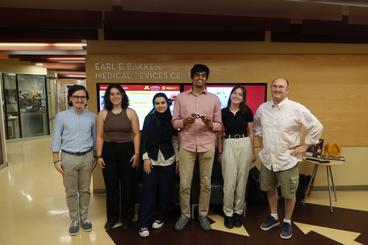
In 2020 1 out of 4 older adults fall each year in the U.S. (up from 1 out of 6 in 2010) and indications are the need is going to increase (CAGR <6.3%) for the next 30-years.
Older adults with mobility concerns need an affordable and portable device that is ideal for mobility issues by providing support and stability without compromising affordability, aesthetics, or useability. The solution is a redesigned frame (that does not look ‘medical’) with a sleeker look that is foldable with locking hinges. The frame includes an anti-tip feature with customizable handles and made with sterilizable materials. Auxiliary pieces (e.g. a cane holder) are also anticipated.
Team Members: Jorge Aliaga del Campo, Rohan Janga, Ghaida Sharaf, Sabrina Simkhovich, Katie Stockton
Clinical Lead: Dr. Danny Sachs
Line and Cord Management in the OR
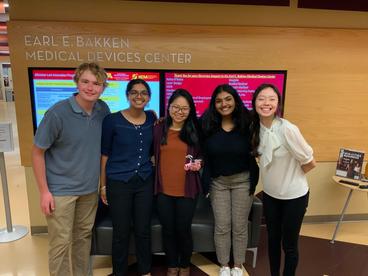
Disorganization contributes to lost productivity and reduces the quality of care. Up to 40 hours per month may be spent trying to find proper equipment. Disorganized cords makes it harder to administer intravenous medication. On average nursing staff spends 12.4-minutes managing the lines and cords in the ICU. 18% of nursing employee injuries are attributed to tripping or falling over medical lines.
Hospital staff and medical personnel need a way to keep medical cords and lines organized without significantly disrupting their workflow. The solution is a mobile reusable cord strap that is customizable to the patient with a safety release to prevent injury.
Team Members: Neha Aramkuni, Trisha Trinh, Sahaana Vasudevan, Soren Toegel, Nhi Lang
Clinical Lead: Dr. Jordan Mattson
Oropharyngeal Camera
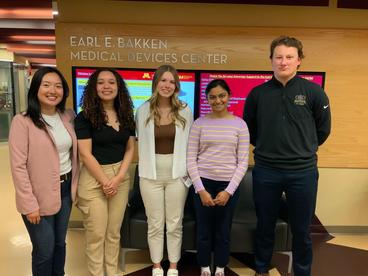
According to the US Department of Health and Human Services: around 70% of oral and pharyngeal cancers (OPC) were detected in their later stages. The NIH reports there were 100,000 new cases estimated to have occurred in 2020. Currently there is no screening specifically for OPC and yet many patients receive an examination during their scheduled dental visits despite improved outcomes when detected early.
Health care providers need a way to detect the early stages of oropharyngeal cancer because oropharyngeal cancer typically metastasizes before it is detected. The solution is a design with a neck that fits comfortably in the throat avoiding a gag-reflex. At the tip of the neck is an LED light with a high resolution camera that provides real-time images to a screen in front of the provider.
Team Members: Salome Augusto, Eesha Hajare, Cole Haraf, Grace Hughes, Iaong Lor
Clinical Lead: Dr. Cynthia Stull
2022 Projects
Abdominal Entry Aid
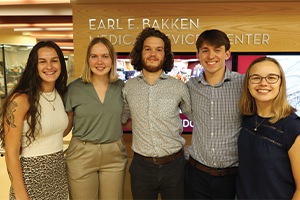
Surgeons accessing the abdomen need to be able to lift the abdominal wall during laparoscopic surgery to gain access to internal sites. Existing tools include clamps, towel clips and a plunger-like device. However these devices can damage skin, cause vascular injuries and risk displacing bowels. They also don’t work well for all patient body types.
Dr. Mattson, a Fellow in Obstetrics, Gynecology and Women’s Health at the University of Minnesota and clinical champion for this project, needs a better tool for grasping the skin to pull the abdominal wall out of the way. The team developed a solution that is low-cost, distributes the force over a large area reducing the risk of tissue damage, and is easy to remove once the procedure is over.
Team Members: Carter Doolittle, Evan Gill, Abigail Kyllo, Samantha Schmitt, and Gracine Sime
Clinical Lead: Jordan Mattson
Watch the team's exit interview and hear about their experience.
Awake Fiberoptic Intubation Simulator
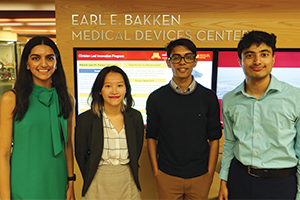
Anesthesia is normally administered before a procedure and the anesthesia prevents the patient from breathing. To help the patient breath, doctors will intubate the patient within minutes of administering anesthesia. During intubation, patients typically lie flat, making the path from the throat to the trachea a straight shot. However, what if the patient was unable to lie flat? Awake Fiberoptic Intubation is an oxygen delivery method used when an anaesthesiologist believes there may be difficulty in placing an oxygen tube down the patient's windpipe. During this procedure, it is typical for the vocal cords to be moving due to coughing, gagging and other movements while the patient is awake.
Dr. Budde, an Anaesthesiologist at the University of Minnesota and clinical champion for this project, needs an intubation simulator that incorporates coughing and vocal cord movements to train residents so they are prepared to practice Awake Fiberoptic Intubation. The solution the team developed is the Motile Trachea Model. The trainer is small-scale, portable, anatomically accurate with moving ‘vocal chords,’ and designed to be cost-effective so that most hospitals and medical institutions can afford one.
Team Members: Aarush Bothra, Shivangi Pandey, Mia Tran, Rana Abdelshahed, and Aniruddha Paranjape
Clinical Lead: Anna Budde
Watch the team's exit interview and hear about their experience.
External Ventricular Drainage Control
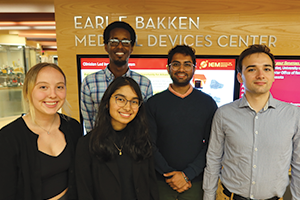
Hydrocephalus is a condition where excess cerebrospinal fluid (CSF) builds up in the ventricles of the brain. To assist the patient, clinicians perform a Ventriculostomy, where an External Ventricular Drain (EVD) is placed to drain excess CSF. The current EVD system must be manually adjusted when the patient moves, they can not measure and drain the fluid at the same time, and there are always concerns about overdraining.
Dr. Miller in the Department of Neurology at the University of Minnesota and clinical champion for this project, needs a better device to stay level with the hydrocephalus patient’s zero-line while providing accurate pressure readings. In response the team designed a wearable sensor that detects changes in the zero-line and measures inline pressure in real-time.
Team Members: Smrithi Karthikeyan, Mihir Madhaparia, Khadar Abdulkadir, Aidan Golish, and Clara Cashin
Clinical Lead: Benjamin Miller
Watch the team's exit interview and hear about their experience.
IV Tubing Organizer
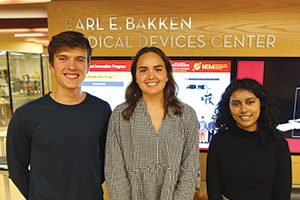
Patients in the ICU often require multiple treatments through multiple feedtubes. All too often the result is a ‘spaghetti syndrome’ of tubing. To untangle the tubing can often cause significant delays for clinical staff.
Doctors Krithika Anand & Elena Zupfer, both Pediatric Anesthesiologists with M Physicians and clinical champions for this project, need a tool to keep multiple tubing organized and prevent ‘spaghetti syndrome.’ The solution the team developed was a low-cost organizing device that prevent the tubes from intertwining and allows clinicians to quickly and easily identify which tube is carrying what treatment.
Team Members: Kyra Van Batavia, Abarna Anandaraj, and Theo Kakacek
Clinical Leads: Krithika Anand and Elena Zupfer
Watch the team's exit interview and hear about their experience.
Modular Resistance Trainer
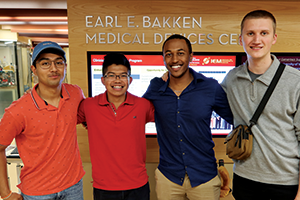
Bedridden patients lose muscle mass within a short period of time, particularly in the lower extremities. If the muscle performance loss is significant enough, the patient may not have the strength to return home and need to receive care in a rehabilitation center.
Dr Shernan Holtan, a hematologist with the Division of Hematology, Oncology and Transplantation at the University of Minnesota and clinical champion for this project, needs a system to assist patients in retaining their muscle mass/performance during hospital stays. The solution the team produced was a portable, low-cost, high-performance resistance training system that can be placed in any hospital room.
Team Members: Quan Dang, Ketim Lamessa, Srivats Srinivasa, and Alec Wesala
Clinical Lead: Shernan Holton
Watch the team's exit interview and hear about their experience.
2021 Projects
Cerebrospinal Fluid Shunt Failure
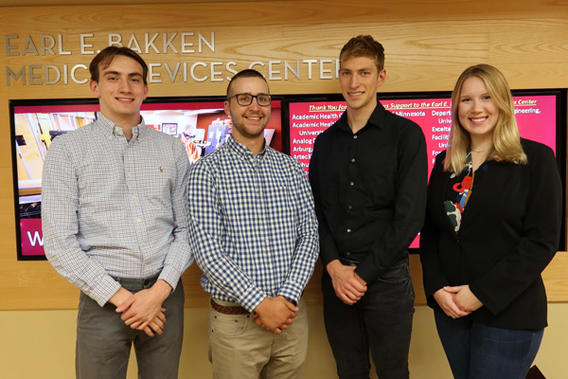
Neurosurgeons need a way to detect and analyze the failures of specific shunt components, because the failures themselves and current shunt failure detection methods can negatively impact patients and cost health centers valuable resources.
Team Members: Isaac Wahlstrom, Alanna Carlson and Peter Fitterer (Not Pictured: Malachi Lehman*)
Clinical Authentication
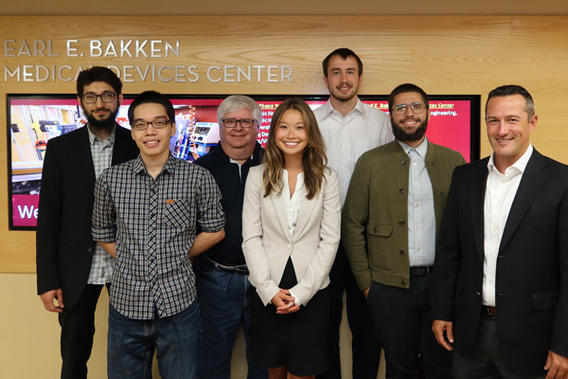
Hospitals need an efficient system to authenticate users of medical devices because improper use threatens the physical wellbeing of patients.
Team Members: Khaled Kansou, Khoi Nhuyen, Ken Hoyme, Briana Chang, David Carlson, Zane Siddiqui and Bill Betten
Digital Forensics
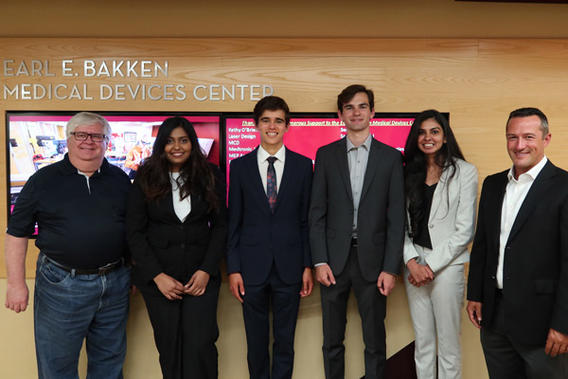
The Healthcare industry needs a better way to log and review data from medical devices in order to identify and distinguish incidents from events to ensure proper patient care.
Team Members: Ken Hoyme, Atishya Ghosh, Adam Boeckermann; Carson Dock, Anu Bompelli and Bill Betten
Enhancements for Newborn Incubators
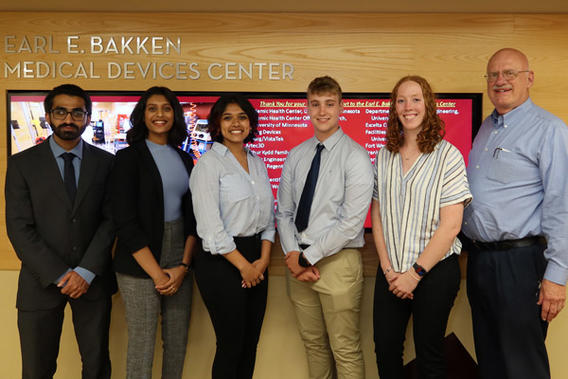
Premature infants need less exposure to disruptive noises because reduced sensory exposure in the Newborn Intensive Care Unit (NICU) is necessary for proper development and the mitigation of hearing impairment.
Team Members: Ali Al Hinaai, Niyati Alluri, Sadhika Prabhu, Alex Olson, Megan Johnson and Roger Sheldon
Fibrosis Detection
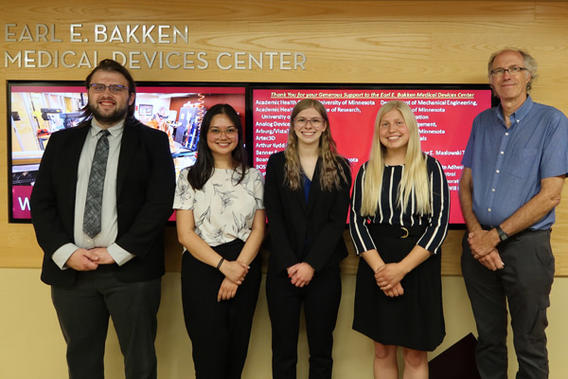
Healthcare workers need a way to assess and quantify fibrosis in patients with breast cancer-related lymphedema to detect early formation of fibrosis and determine treatment goals.
Team Members: Ian Knoll, Isidora Mack, Emily Graba, Hannah Loukusa and William Durfee
Foley Catheter
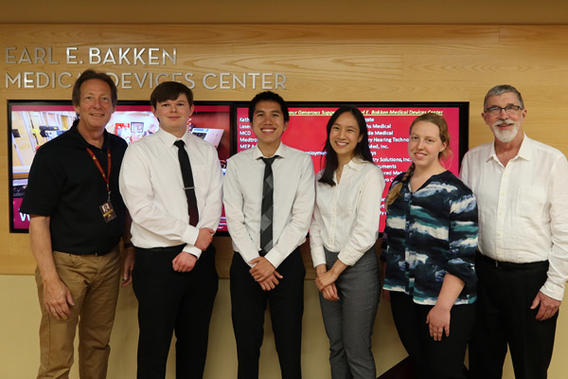
Medical professionals performing catheter insertions require a feedback mechanism to determine if they are applying excessive force that could result in injury to the patient so that subsequent trauma, ensuing costs, and appended hospitalization periods for patients are reduced.
Team Members: Paul Rothweiler, Rick Marcusen, Andy Thai, Vivian Pham, Autumn Schuldt and Paul Gleich
Hydrocele
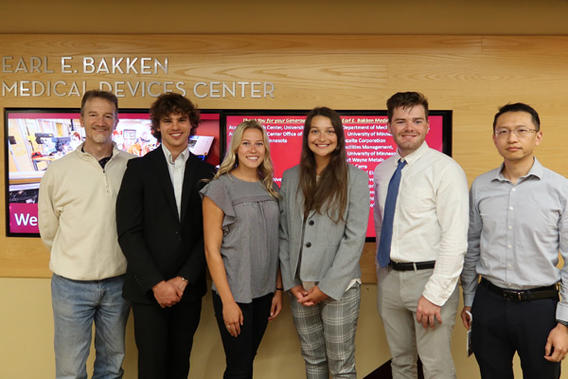
Physicians need a way to perform an office-based hydrocele treatment because the procedure requires a great amount of time, money, and staff to complete.
Team Members: Eric Little, Anders Gloege Torp, Molly Reighard, Gabriella Mullally, Kaden Braden and Chunxiao Guo
2019 Projects
Self Cannulation
- Project Sponsor: Ibrahim Yekinni
- Project Mentor: Felix Landaeta
- Project Manager: Anu Bompelli
- Team Members: Sneha Sinha, Rahema Rashid, Camden Sundin, and Sylvia Wu
Wearable Athletic Sensing
- Project Sponsor: Ben Utecht
- Project Mentor: Adam Black
- Project Manager: Emily Brown
- Team Members: Zach Lant, Jacob Herbers, Grant Ryerse, and William Guo
Prosthetic Hip
- Project Sponsor: Lyndsey Calvin
- Project Mentor: Eric Little
- Project Manager: Jordan Stanek
- Team Members: Andrew Payton, Jose David Hernandez, David Rey, and Changuk Jeong
GI Motility
- Project Sponsor: Matt Johnson
- Project Mentor: Paul Rothweiler
- Project Manager: Cara Piazza
- Team Members: Aishwarya Pillai, Dani Alfonzo, Nisha Panigrahy, and Bre Retherford
Vascular Doppler
- Project Sponsor: Jack Doenges
- Project Mentor: Dan Glumac
- Project Manager: Matt Kubala
- Team Members: Sayontan Roy, Vibha Mavanji, Brooks Hodenfield, and Jeremy Wales
Urethral Erosion
- Project Sponsor: Paul Gleich
- Project Mentor: Amy Hoelscher
- Project Manager: Daniel Burford
- Team Members: Rebecca Breuer, Hannah Spargur, and Junchi Feng
2018 Projects
Perianal Workstation
- Project Sponsor: Henry Buchwald
- Project Mentor: Felix Landaeta
- Project Manager: Shannen Kizilski
- Team Members: Matthew Kubala, Jakob Osterberg, Julia Clarin, and Eesha Irfanullah
Catheter Insertion Simulator
- Project Sponsor: Paul Gleich
- Project Mentor: Adam Ahmad
- Project Manager: Austin Andrews
- Team Members: Rachel Green, Molly Kaissar, and Nickhil Gupta
Low Profile Airway Stent
- Project Sponsor and Mentor: Doug Devens
- Project Manager: Cara Piazza
- Team Members: Chi Vang, Elizabeth Lindgren, and Miles Wing
Veterinarian Surgery Device
- Project Sponsor: Douglas McMahon
- Project Mentor: Paul Rothweiler
- Project Manager: John Thomalla
- Team Members: Sophia Meister, Amanda Nowacki, and Soumya Joseph
Brain Craniectomy Helmet
- Project Sponsor: Luke Rogers
- Project Mentor: Eric Little
- Project Manager: Anthony Itambo
- Team Members: Daniel Burford, Mary Korlin-Downs, Rohan Thakur, and Isabelle Jones
Facial Dermal Filler
- Project Sponsor: Omotara Sulyman, Sofia Lyford-Pike
- Project Mentor: Adam Black
- Project Manager: Grace Aysta
- Team Members: Samiha Khan, Jordan Stanek, and Shiping Yi
2017 Projects
Innovative Light Bulb
- Project Sponsors: Gwen Fischer and Tina Slusher
- Project Mentor: Steve Saliterman
- Project Manager: Jen Chmura
- Team Members: Abigail Sawyer, Brett Levac, Zhen Xin Wong, and Jennifer Thomalla
Warm Oxygen Delivery
- Project Sponsors: Gwen Fischer and Andrew Wu
- Project Mentor: Christie Traczyk
- Project Manager: John Thomalla
- Team Members: Minh-Uyen Nguyen, Sharath Nair, Sydney Narloch, and Rohan Thakur
Canine Pedicle Screw Placement
- Project Sponsor and Mentor: Ben Arcand
- Project Manager: Erik Stroman
- Team Members: Tiffany Tran, Ryan Kruchten, and Nehasri Duggirala
External Nose Metrics
- Project Sponsor: Omotara Sulyman
- Project Mentor: Adam Black
- Project Manager: Justinus Hartoyo
- Team Members: Joshua Cadavez, Nickhil Gupta, and Samiha Khan
Urinary Catheter
- Project Sponsor: Shawn Sisco
- Project Mentor: Eric Little
- Project Manager: Anthony Itambo
- Team Members: Andrew Wloch, Bita Rajablou, and Austin Andrews
Flexible IV Catheter
- Project Sponsor: Kris Flahaven
- Project Mentor: Paul Rothweiler
- Project Manager: Izack Angerhofer
- Team Members: Rachel Green, Caroline Dai, Elizabeth Lindgren, and Andrew Zhou
2016 Projects
Cesearean Sling
- Project Sponsors: Kris Flahaven and Mark Eggen
- Project Mentor: Paul Rothweiler
- Project Manager: Grace Joseph
- Team Members: Jennifer Kim, Nick Gulachek, and Joshua Cadavez
Video styl-ET-ube
- Project Sponsor: Tom Viren
- Project Mentor: Eric Little
- Project Manager: Ben Watters
- Team Members: Girish Kumar Ganesh, Izack Angerhofer, and Grace Aysta
Biomechanics Exoskeleton Modeling (Magic Arms #1)
- Project Sponsor: Angie Conley
- Project Mentor: Eric Little
- Project Manager: Trevor Laughlin
- Team Members: Monica Illikman, Elsa Hauschildt, and Kaitlin Maile
Chassis (Magic Arms #2)
- Project Sponsor: Angie Conley
- Project Mentor: Brian Brown
- Project Manager: Margi Merline
- Team Members: Nathan Angerhofer, Hana Bouddlali, and Bret Anderson
Toothbrush
- Project Sponsor and Mentor: Will Durfee
- Project Manager: Spencer Yueh
- Team Members: Abigail Shaffer and Luke Truitt
Warming Device for Peripheral Artery Disease
- Project Sponsor: Hirsch Mark Bakken
- Project Mentor: David Amor
- Project Manager: Fadumo Yusuf
- Team Members: Louis Ting and Anmol Jaguste
Digital PEP Spirometer
- Project Sponsor and Mentor: Brian Krohn
- Project Manager: Ali Al Hinaai
- Team Members: Christine Walz, Sai Pooja Bajjuri, and Caitlyn Quinn
Neuropathy Measuring Device
- Project Sponsor: William Kennedy
- Project Mentor: Adam Black
- Project Manager: Sahani Wijesinghe
- Team Members: Kristen Lewis, Jonathan Cabak, and Toshi Higashi
2015 Projects
Wearable Vitals Sensors
- Project Sponsor: ZATER, Inc.
- Projects Manager: Matthew
- Team Members: Joey Liu, Zarjish Yousa, and Damola Badewa
Compression Stocking Donner
- Project Sponsor: Judith Hechter
- Projects Manager: Becky
- Team Members: Monica Illikman, Cyrus Nouraee, and Tiance Xia
Pressure Ulcer Feedback Monitor
- Project Sponsor: Jean Dominique Morancy
- Projects Manager: Katelyn Lichte
- Team Members: Jaron Olsoe, Wei-Wei Wu, and (Jay) Jia Hu
Peripheral Neuropathy Foot Injury Diagnostic
- Project Sponsor: Judith Hechter
- Projects Manager: Joseph Schaefer
- Team Members: Jessica Barry, Austin Barmore, and Tatjana Mortell
Rotational Lung Biopsy Device
- Project Sponsors: Mark Fister and Erhan Dincer
- Project Mentor: Mark Fister
- Projects Manager: Nia Balch
- Team Members: Channa Duong, Omar Hammami, and Yrithu Pillay
2014 Projects
Ventilator Induced Atrophy
- Project Mentor: John Ballard and Jesus Cabrera
Vaginal Dilator
- Project Mentor: Laura Paulson
Whizzinator
- Project Mentor: Laura Paulson
OR Suction Device
- Project Mentor: Laura Paulson
Lower Urinary Tract Dysfunction Diagnostic
- Project Mentor: Laura Paulson
Pressure Modulating Spine Brace and Cast
- Project Mentor: Laura Paulson
Peripheral Neuropathy Testing Device with Heat
- Project Mentor: William Kennedy
Peripheral Neuropathy Testing Device with Vibration
- Project Mentor: William Kennedy
Simulator for Catheterization of Obese Female Patients
- Project Mentor: Paul Gleich
Simulator for Catheterization of Men
- Project Mentor: Paul Gleich
Bladder Stethoscope
- Project Mentor: Paul Gleich
Hand-held, Low-cost Ultrasound Unit to Determine the Size and Volume of Bladder
- Project Mentor: Paul Gleich
PCB Milling Machine
- Project Mentor: Darrin Beekman